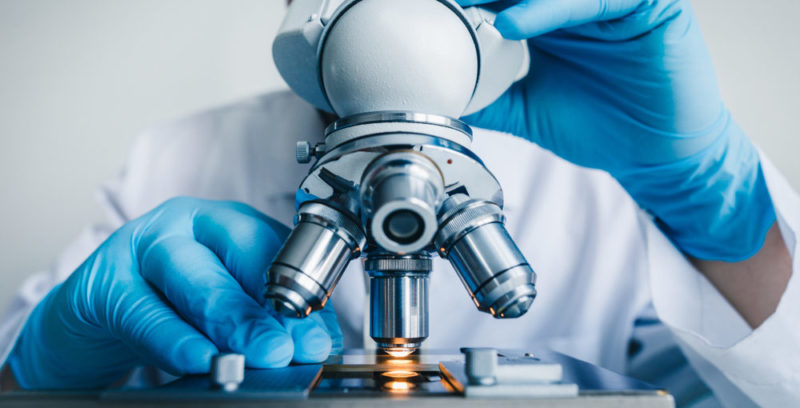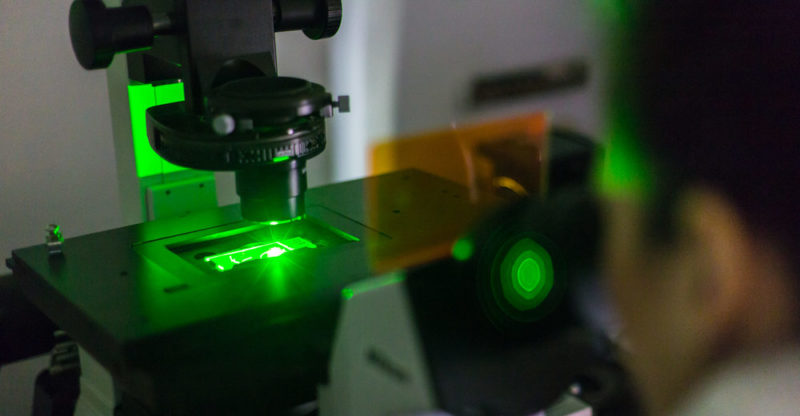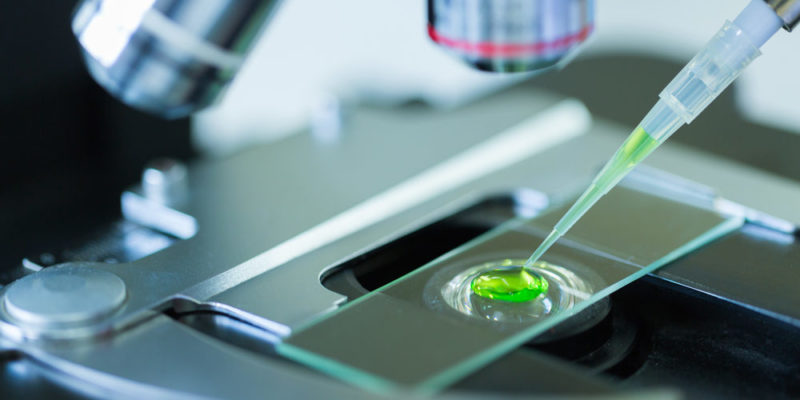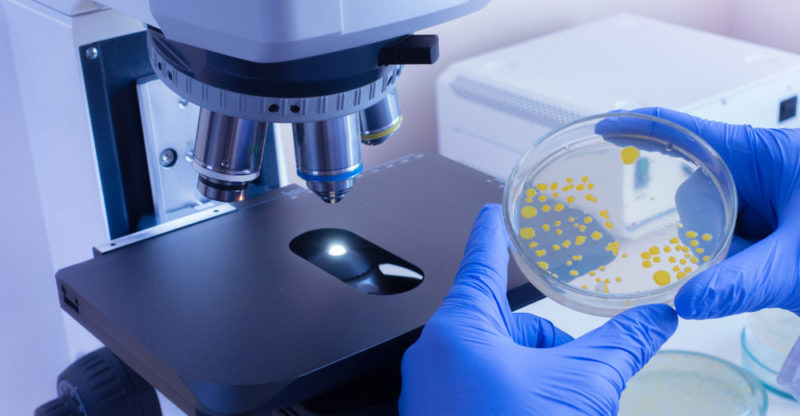We explain what a microscope is, how it evolved and the parts that make it up. In addition, its general characteristics, types, uses and more.
What is the microscope?
The microscope is a tool that allows you to observe objects and elements too small to be seen with the naked eye. Its name comes from the Greek “ micros ” (tiny) and “ scopéo ” (to look), and it uses the principle of refraction and reflection of light to generate a controlled magnification of the image of matter .
The microscope was invented in the 16th century through an optical system of magnifying lenses, which has been perfected until today, when there are electronic variants so powerful that they allow the smallest objects to be glimpsed.
This instrument allowed a deep understanding of microscopic life and therefore changed the understanding of life in its entirety, thus becoming an indispensable tool for modern medicine, biology and pharmacology.
first microscope
The first known microscope was made by Zacharias Janssen in 1590 , who was also involved in the invention of the telescope. However, there are many points of disagreement on the subject, since Janssen was also a known forger.
In any case, the appearance of this instrument allowed the revelation of the microscopic dynamics of the human body and the observation of a living cell for the first time in 1665.
evolution of the microscope

It is said that by 1930 compound optical microscopes had reached the limit of their capabilities, which were around 500X and 1000X magnification .
However, in the following years the electron microscope was invented , which allows magnifications of 100,000X to be reached, useful for observing the structures inside living cells. More and more powerful variants of the instrument are still being studied today.
Parts that make up the microscope

Conventional light microscopes (simple and compound), have the following parts:
- Arm. The physical support that joins the base of the microscope with the lenses and the optical viewfinder. Also called column.
- Base. The bottom of the microscope, where the instrument rests and which may contain the light source (if built-in). It is also called foot .
- Eyepieces. This is the name given to the lenses through which we look and receive the amplified image.
- Illuminator. Device incorporated or not to the microscope, which provides the necessary light to observe matter. In the most basic microscopes an external light source must be provided.
- Table. Platform on which the specimen or substance to be observed amplified is located. It has clips to hold it and prevent movement.
- Drum or revolver. Part of the microscope with the different optical lenses (objectives), which usually rotate to vary the magnification.
- Goals. This is the name given to the different optical lenses of a microscope, which offer different magnification measures and are usually interchangeable with each other.
- capacitors Lenses that focus the light beam on the observed material.
- Macrometric and micrometric screws. They modulate the distance between the lenses and the observed matter, to allow a greater or lesser focus according to the observer's eye .
Microscope Refraction and Reflection

- Refraction. One of the two fundamental principles of any microscope is the refraction of light, which raises the deviation of light beams when they cross a given medium to another. Calculated to obtain a specific effect through the series of microscope lenses, this phenomenon allows the image to be enlarged up to several times its actual size.
- Reflection. Similar to the previous case, the principle of light reflection is the one that allows us to predict the behavior of light when it strikes a body whose surface rejects it. It is the principle that operates in mirrors and allows, in the microscope, to manipulate light beams to concentrate them on the object to be observed against the light.
types of microscopes
 There are different kinds of microscopes, according to the method used to magnify the images of microscopic matter, namely:
There are different kinds of microscopes, according to the method used to magnify the images of microscopic matter, namely:
- Optical microscope (simple). The most common and the first to be invented uses an optical lens to enlarge the image of what is observed.
- Compound microscope. A step forward from the optical (also called light) microscope, it uses a complex system of variable and combined lenses to provide different types of magnification on the observed matter.
- Digital microscope. A contemporary variant that takes advantage of computerized technology to enlarge the image through very high resolution cameras.
- fluorescent microscope. This variant of the light microscope uses fluorescence or phosphorescence useful for specific studies of the subject.
- Stereo or dissection microscope. It has two objectives and two ocular lenses to provide the user with a three-dimensional optical experience.
- Electronic microscope. One of the most advanced and important today, it uses electron flows to illuminate the observed matter and thus obtain magnification ranges impossible with other microscopes.
Optics and microscope lenses
Microscopes would not exist without the development of geo , which allows us to understand the system of relationships of light when it hits the surface of the lens. These can be concave or convex , depending on the orientation of their curvature, or they can be simple or complex according to their surface structure. In this, the microscope is closely related to the telescope.
Preparation of the object to be observed
 To use the microscope, we must prepare the object to be observed, mounting it on a transparent glass sheet called a slide . Then it is covered with another thinner and smaller sheet called a coverslip and, if necessary, stains or dyes are added to identify what is being sought.
To use the microscope, we must prepare the object to be observed, mounting it on a transparent glass sheet called a slide . Then it is covered with another thinner and smaller sheet called a coverslip and, if necessary, stains or dyes are added to identify what is being sought.
virtual microscopes
This is the name given to a novel technique for analyzing data areas of a cytological or histological sample (cells and tissues), using a computer system that reproduces the information captured in a simulated environment.This technique is currently under development , since it would allow the full integration of computer systems to scientific research or its transmission over great distances and in real time, taking advantage of new technologies inspired by the Internet .
This also represents a step towards the automation of certain scientific analysis processes that could dispense with the constant intervention of man, such as histological examinations or blood samples.
Importance of the microscope for medicine
 The birth of microscopy and the use of this tool in the various life sciences prompted a scientific revolution that was already insinuating itself in theoretical terms.
The birth of microscopy and the use of this tool in the various life sciences prompted a scientific revolution that was already insinuating itself in theoretical terms.The verification of life forms smaller than the visible completely abolished the magical or religious theories about the disease , and opened a scientific window for the verifiable study of the different infectious agents ( viruses , bacteria , protozoa ) and of the chemistry body's own (blood tests).
Microscope care
A microscope must be used with some care so as not to spoil its delicate operating system, such as carrying it with both hands, since a fall is fatal ; do not move it while using it; do not touch the lenses or the eyepiece, as they get dirty easily; or avoid for the same reasons that the end of the objective touches the observed substance when approaching it to focus.The above content published at Collaborative Research Group is for informational and educational purposes only and has been developed by referring reliable sources and recommendations from technology experts. We do not have any contact with official entities nor do we intend to replace the information that they emit.
MA student of the TransAtlantic Masters program at UNC-Chapel Hill. Political Science with a focus on European Studies. Expressed ideas are open to revision. He not only covers Technical articles but also has skills in the fields of SEO, graphics, web development and coding. .
Leave a reply
Your email address will not be published. Required fields are marked *Recent post

Sport: What Is It, Types, Risks, Features, Characteristics and Examples

Dogs: Emergence, Features, Characteristics, Feeding and Breeds

Story: Definition, Elements, Structure, Features and Characteristics

